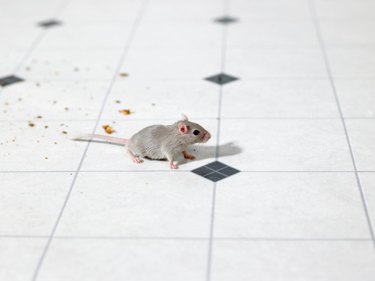
A female mouse can produce up to 10 litters of offspring per year, making mouse control a perennial problem for many housekeepers. Numerous traps and poisons are available to help with the problem, each with its own advantages and drawbacks. Poison pellets come in numerous colors, but green is common since it is a color often associated with poison. These pellets are simple to use and do not require contact with mice, but they have the disadvantage of being potentially dangerous to humans and other animals.
Toxic Pellets
Video of the Day
Toxic mouse pellets use bromethalin, cholecalciferol or zinc phosphide to poison the rodent. While these poisons are effective, they are also lethal to other mammals, and there is no known antidote. Their use is best left to professionals since they pose a significant risk if improperly applied and they are regulated by law in some places.
Video of the Day
Anticoagulant Pellets
Anticoagulant mouse pellets use chlorophacinone, diphacinone, warfarin, brodifacoum, bromadiolone or difethialone. These chemicals prevent the mouse's blood from clotting and cause death through internal bleeding. The first three chemicals in the list are older and less effective, requiring more than one feeding to be lethal. There has also been concern that some house mice may have developed resistance to warfarin. The last three chemicals in the list are effective and generally deliver a lethal dose in a single feeding, although death takes several days to occur. You can treat accidental consumption of anticoagulant pellets with vitamin K and other antidotes.
Use
Anticoagulant mouse pellets have a grainy odor and contain numerous inert ingredients which appeal to mice. You can get the pellets in individual trays and set them out as they are, or place them into covered dispensers which lock and allow access only through a small hole. Place the pellets in the same locations where mouse droppings have appeared, preferably near walls since mice like to scurry along them. Surrounding floors and surfaces should be free from food which might distract mice from the pellets. In places where it is not possible to remove other food sources, such as a barn, distribute the pellets in numerous locations, not more than 10 feet apart. Although poison does not allow an exterminator to verify how many mice have been killed, keeping track of how many pellets remain in the dispenser will show whether or not the mice are eating it, and watching for mouse droppings will show if mice are still active.
Safety
While anticoagulant pellets are effective and easy to use, they are not appropriate for all households. Most health departments and county extension offices recommend traps as a superior method of mouse control. Mice like to carry the pellets away and hide them in nooks and crannies. Once the mice die, leftover pellets will remain in the most unlikely places, making it impossible to be certain all the pellets have been cleaned up. The poison from anticoagulant mouse pellets can be absorbed through the skin as well as through oral consumption, so wear rubber gloves while handling pellets and follow all manufactures' directions.
- University of Nebraska–Lincoln Extension: Controlling House Mice; Stephen Vantassel, et al.
- Illinois Department of Public Health: Prevention and Control
- Expert Witness/Entemology: Commensal Rodents-Rats and Mice; Dr. Richard Kaae
- New York State Department of Health: Mouse Control
- University of Kentucky College of Agriculture: Control of Mice; Michael F. Potter
- DIY Pest Control: Fastrac Place Pacs: MSDS
- HACCO Inc.: Prozap Zinc Phosphide Pellets: MSDS
- Farnam Companies: Just One Bite Mouse and Rat Bait Pack Pellets: MSDS